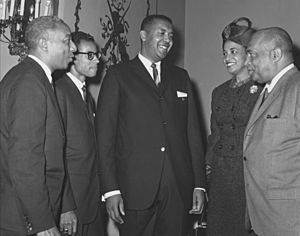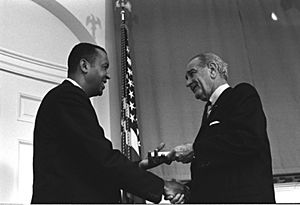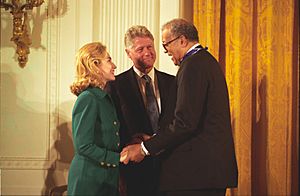A. Leon Higginbotham Jr. facts for kids
Quick facts for kids
A. Leon Higginbotham Jr.
|
|
|---|---|
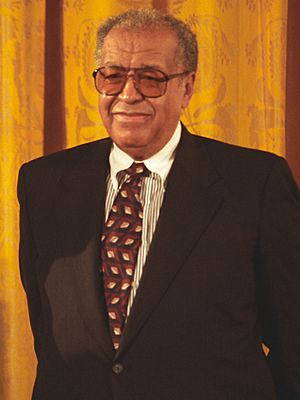
Higginbotham with Bill Clinton at a Presidential Medal of Freedom ceremony, 1995.
|
|
| Senior Judge of the United States Court of Appeals for the Third Circuit | |
| In office January 31, 1991 – March 5, 1993 |
|
| Chief Judge of the United States Court of Appeals for the Third Circuit | |
| In office January 15, 1990 – January 31, 1991 |
|
| Preceded by | John Joseph Gibbons |
| Succeeded by | Dolores Sloviter |
| Presiding Judge of the United States Foreign Intelligence Surveillance Court of Review | |
| In office May 19, 1979 – May 18, 1986 |
|
| Appointed by | Warren E. Burger |
| Preceded by | Seat established |
| Succeeded by | Collins J. Seitz |
| Judge of the United States Court of Appeals for the Third Circuit | |
| In office October 11, 1977 – January 31, 1991 |
|
| Appointed by | Jimmy Carter |
| Preceded by | Francis Lund Van Dusen |
| Succeeded by | Theodore McKee |
| Judge of the United States District Court for the Eastern District of Pennsylvania | |
| In office March 17, 1964 – November 7, 1977 |
|
| Appointed by | Lyndon B. Johnson |
| Preceded by | James Cullen Ganey |
| Succeeded by | Louis H. Pollak |
| Personal details | |
| Born |
Aloyisus Leon Higginbotham Jr.
February 25, 1928 Ewing Township, New Jersey |
| Died | December 14, 1998 (aged 70) Boston, Massachusetts |
| Spouse | Evelyn Brooks Higginbotham |
| Education | Purdue University Antioch College (BA) Yale Law School (LLB) |
A. Leon Higginbotham Jr. (born February 25, 1928 – died December 14, 1998) was an important American figure. He was a champion for civil rights, a historian, and a trusted advisor to presidents. He also served as a United States federal judge. From 1990 to 1991, he was the Chief Judge of the United States Court of Appeals for the Third Circuit.
Higginbotham was the seventh African American to become an Article III judge in the U.S. He was also the first African American United States district judge for the United States District Court for the Eastern District of Pennsylvania. He spent almost 30 years as a federal judge. In 1995, President Bill Clinton gave him the Presidential Medal of Freedom, a very high honor. He was known informally as "Leon."
Contents
Early Life and Education
Higginbotham was born on February 25, 1928, in Ewing Township, New Jersey, near Trenton, New Jersey. His mother, Emma Lee Higginbotham, worked as a maid. His father, Aloyisus Leon Higginbotham Sr., was a factory worker. Leon grew up in a mostly African-American neighborhood. He went to a segregated (separate for different races) grammar school.
He attended Lincoln School, a segregated high school in Trenton. Before him, no Black student had been put on the academic track for college. This was because Latin, a required subject, was not taught in Black elementary schools. His mother convinced the junior high principal to let him take a second-year Latin course. He had never studied first-year Latin. His Latin teacher tutored him at her home during the summer to help him succeed.
His family did not have much money. So, Leon worked while he was in school. He mowed lawns, shoveled snow, and worked as a bus boy at a hotel. When he was 15, he changed his birth certificate to get working papers. This allowed him to work in a pottery factory a year earlier than the law allowed.
College Years
At 16, Higginbotham started at Purdue University in West Lafayette, Indiana. He chose Purdue because it accepted Black students. It was also cheaper than Rutgers University and offered discounts for good grades. He wanted to be an engineer, and Purdue was known for its engineering programs.
When he started in 1944, Purdue had about 6,000 white students and only 12 Black students. Black students were not allowed to live in the regular dorms. Higginbotham and the other Black students lived in an unheated attic building called International House. He asked the university president if they could sleep in a heated dorm section. The president reportedly said, "The law doesn't require us to put you in those dormitories. The law doesn't even require us to let you in. You take it or leave it."
This experience, along with being unable to stay in a hotel with his debate team because he was Black, changed his path. He decided that engineering would not help fight unfairness. He realized he wanted to study law to "challenge the system."
In 1945, Higginbotham moved to Antioch College in Yellow Springs, Ohio. Another Black student, Coretta Scott, who later married Martin Luther King Jr., also started at Antioch that day. At Antioch, Higginbotham led the college's NAACP chapter. He successfully convinced the Governor of Ohio to support lowering the voting age to 18. He earned his Bachelor of Arts degree in 1949.
Law School Experience
In the fall of 1949, Higginbotham began studying at Yale Law School. He worked as a butcher to help pay for his studies. He was part of the moot court team, which practices mock trials. He reached the finals of a moot court competition. One of the judges was Tom C. Clark from the Supreme Court of the United States.
As a first-year student, he was a research assistant for a professor. This allowed him to attend a Supreme Court case called Sweatt v. Painter. This case was about allowing Black students into the University of Texas at Austin. Thurgood Marshall, who later became a Supreme Court Justice, argued the case. Higginbotham later said watching Marshall argue made him feel he had "witnessed the birth of racial justice." He received his Bachelor of Laws from Yale in 1952. Later, in 1969, he became the first Black trustee of Yale. He pushed for women to be allowed into the university's undergraduate program.
Legal Career
After law school, Higginbotham tried to find work at law firms in Philadelphia, Pennsylvania. However, he could not get a job at any major firms because of his race. He started his career as a law clerk for Judge Curtis Bok in Philadelphia.
In 1953, he became an assistant district attorney for Philadelphia County. Before him, no Black lawyer had argued cases for the state in these courts. Higginbotham was given the chance to argue cases in both the Court of Common Pleas and the Superior Court of Pennsylvania.
In 1954, Higginbotham joined a private law firm. It was the first African American law firm in Philadelphia, called Norris, Schmidt, Green, Harris, and Higginbotham. Three of his partners later became judges. Higginbotham worked there until 1962, handling criminal defense and personal injury cases. From 1960 to 1962, he was president of the Philadelphia chapter of the NAACP.
Public Service
While working in private law, Higginbotham also held several government jobs. He was a special Deputy State Attorney General from 1956 to 1962. He also worked for the U.S. Department of Justice and on the Pennsylvania Human Rights Commission. He was also a teacher at Rutgers University Law School.
Federal Trade Commission
In 1962, President John F. Kennedy appointed Higginbotham as a commissioner on the Federal Trade Commission (FTC). This made him the first African American to be a commissioner on any U.S. regulatory commission. He became a strong supporter of President Kennedy. He attended many White House events, including a state dinner.
As of 2021, Higginbotham is one of only three African Americans to have served on the FTC.
U.S. District Court Judge
Attorney General Robert F. Kennedy suggested to President Kennedy that Higginbotham become a judge. In 1963, Kennedy nominated him for a seat on the United States District Court for the Eastern District of Pennsylvania. However, his nomination was delayed by Mississippi Senator James Eastland. Eastland was a strong supporter of racial segregation.
Because of the delay, Higginbotham's nomination expired after President Kennedy's death. But President Lyndon B. Johnson then appointed him on January 6, 1964. He was confirmed by the United States Senate on March 14, 1964. He officially became a judge on March 17, 1964, at 36 years old. He served on this court until November 7, 1977.
Advisor to President Johnson
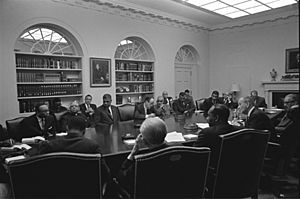
After becoming a judge, Higginbotham became close with President Johnson. He attended many White House events. The day after the assassination of Martin Luther King Jr., Higginbotham was called to the White House. He joined meetings to advise the President on how to respond to King's death. Other important figures like Thurgood Marshall and Hubert Humphrey were also there. Higginbotham stayed at the White House and continued to advise the President for days.
In 1967, Higginbotham arranged for President Johnson to visit North Philadelphia. Johnson saw a community working to fix up an old police station. Higginbotham said Johnson was "elated" to see the real results of their efforts. A year later, after the assassination of Robert F. Kennedy, President Johnson again asked Higginbotham for help. He appointed him to the Commission on the Causes and Prevention of Violence. In 1968, he was Vice Chairman of President Johnson's Kerner Commission.
Higginbotham attended the opening of Johnson's Presidential library. Johnson called him "one of my closest advisers." Higginbotham later said he was grateful for the comment. He met with Johnson two weeks before Johnson's death in 1973. They discussed the career of newly elected Congresswoman Barbara Jordan.
Judicial Career
Higginbotham served as a District Court judge for 13 years. His office was in the Federal Courthouse in Philadelphia. Even as a new judge, he still faced racism. On his first day, a guard yelled at him for parking in the judges' area. When Higginbotham said he was Judge Higginbotham, the guard apologized. Higginbotham remembered this as typical of what minorities and women faced.
He did not experience such behavior from his fellow judges. However, he was the youngest person ever appointed to the Eastern District Court. He recalled that age differences were sometimes a challenge.
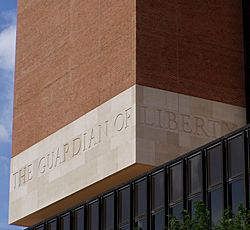
In 1974, Higginbotham wrote an important opinion in a case about racial discrimination. He explained why he, as an African American judge involved in civil rights, should not have to step down from the case. He ruled that a judge should not be forced to step aside just because they belong to a minority group. Other judges, including Black judges facing similar requests, have followed his opinion.
President Jimmy Carter nominated Higginbotham to the United States Court of Appeals for the Third Circuit on September 19, 1977. He was confirmed by the United States Senate on October 7, 1977. He officially became a judge on October 11, 1977. His new office was in the James A. Byrne United States Courthouse in Philadelphia.
Higginbotham described his approach as a judge as being like Justice Benjamin N. Cardozo. He believed in an "evolutionary concept" of what is fair and just in society. He did not believe in a very strict interpretation of laws that might ignore fairness. He was Chief Judge of the Court of Appeals from 1990 to 1991. He retired from the bench on March 5, 1993.
In 1991, Judge Higginbotham wrote an "Open Letter to Justice Clarence Thomas." In this letter, he shared his "concern and sorrow" that Justice Thomas might turn away from the long struggle for racial equality.
Many notable people worked as law clerks for Judge Higginbotham. These included Eleanor Holmes Norton, who became the first female Chair of the U.S. Equal Employment Opportunity Commission. Another clerk was Sandile Ngcobo, who later became Chief Justice of South Africa.
Academic and Post-Judicial Career
Higginbotham was a professor at the University of Pennsylvania for 24 years. He taught in the sociology department and later in the law school. He also served as a trustee for the University of Pennsylvania, Yale University, and Thomas Jefferson University.
After retiring from being a federal judge at age 65, Higginbotham joined a law firm called Paul, Weiss, Rifkind, Wharton & Garrison. He also became a professor at Harvard University's John F. Kennedy School of Government. He held both positions until his death.
Higginbotham advised the Congressional Black Caucus on voting rights cases before the Supreme Court. In 1996, he advised the company Texaco on how to improve its human resources and diversity.
Publications and Speeches
In 1978, Higginbotham published a book called In the Matter of Color: Race and the American Legal Process 1: The Colonial Period. He also wrote over 100 articles for law reviews. His second wife, Dr. Evelyn Brooks Higginbotham, was also a respected historian. His second book, Shades of Freedom: Racial Politics and Presumptions in the American Legal Process, was published in 1996. He also helped law professor Anita Hill publish a book. Even after retiring, he gave over 100 speeches to encourage younger generations to keep fighting for racial justice. He received more than 60 honorary degrees from universities.
Work in South Africa
Higginbotham played a role in South Africa's move to democratic elections. He visited South Africa in 1982 and was shocked by the racial oppression he saw. After apartheid (a system of racial segregation) ended, Higginbotham worked with Nelson Mandela. He started the South Africa Free Election (SAFE) Fund. He raised millions of dollars to support fair elections in South Africa. He was one of the international mediators for South Africa's first multi-racial elections in 1994. After the election, he helped South Africa's new government write a new constitution.
Nelson Mandela later said that Judge Higginbotham's work "made a critical contribution to the course of the rule of law in the United States." He also said Higginbotham "played an important role in [South Africa's] first democratic elections."
Testimony at Clinton Impeachment Hearings
On December 1, 1998, just two weeks before he died, Higginbotham spoke before the United States House Committee on the Judiciary. This was part of the hearings about whether to impeach President Clinton. Higginbotham argued that Clinton's actions were not serious enough for impeachment. He gave an example of someone driving slightly over the speed limit and then lying about it. He suggested this was not a reason to remove a president.
Higginbotham ended his testimony by asking the committee to think carefully. He said their vote would greatly impact the future of the United States.
After Higginbotham's death, President Clinton said, "I shall never forget how he spoke up for me."
Death
A. Leon Higginbotham Jr. died on December 14, 1998, in Boston, Massachusetts. He had suffered several strokes. President Clinton called him "one of our nation's most passionate and steadfast advocates for civil rights." Jesse Jackson said Higginbotham was as important to the second half of the 20th century as Thurgood Marshall was to the first half.
Personal Life
Higginbotham was married twice and had two sons and two daughters. In 1948, he married Jeanne L. Foster, and they had three children. This marriage ended in 1988. He then married Evelyn Brooks Higginbotham, who survived him.
His nephew, F. Michael (Mike) Higginbotham, is a law professor. He has written works with his uncle and in his uncle's voice.
Awards and Honors
Higginbotham was elected to the American Philosophical Society in 1978. He also joined the American Academy of Arts and Sciences in 1993. In 1995, President Clinton gave him the Presidential Medal of Freedom. In 1996, the NAACP gave him its highest honor, the Spingarn Medal.
He received the first Spirit of Raoul Wallenberg Humanitarian Award in 1994. This was for his work helping children through the legal system and his human rights efforts in South Africa. The Lawyers' Committee for Civil Rights Under Law named its annual A. Leon Higginbotham Corporate Leadership Award after him. Higginbotham received honorary degrees from 62 different universities.
Images for kids
See Also
 In Spanish: A. Leon Higginbotham Jr. para niños
In Spanish: A. Leon Higginbotham Jr. para niños
- List of African-American jurists
- List of first minority male lawyers and judges in Pennsylvania


